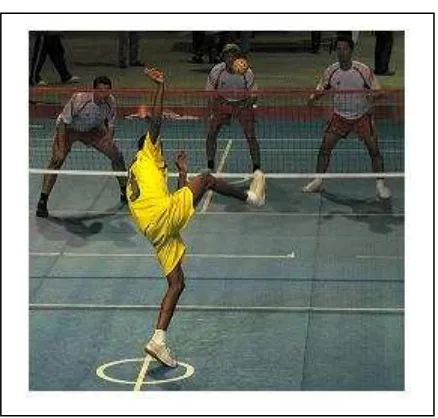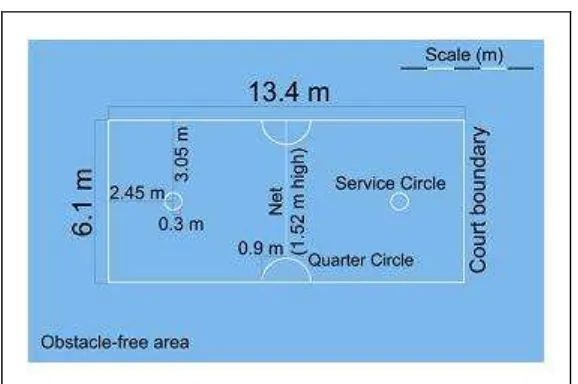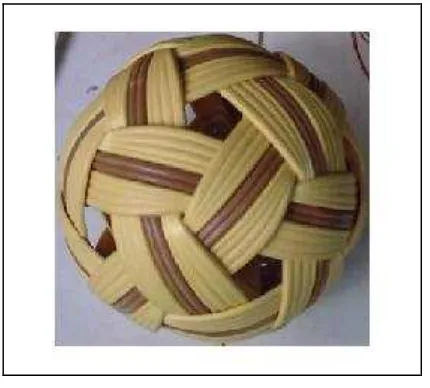i DEVELOPMENT OF CONTROL SYSTEM FOR SEPAK TAKRAW
LAUNCHER MODEL
MOHANDAS SAGARAN
Laporan ini dikemukakan sebagai
memenuhi sebahagian daripada syarat penganugerahan
Ijazah Sarjana Muda Kejuruteraan Mekanikal (Rekabentuk & Inovasi)
Fakulti Kejuruteraan Mekanikal University Teknikal Malaysia Melaka
ii “Saya akui laporan in adalah hasil kerja saya sendiri kecuali ringkasan dan petikan
yang tiap-tiap satunya saya telah jelaskan sumbernya”
Tandatangan : ……….. Nama Penyelia I : ………..………
iv ACKNOWLEDGEMENTS
v ABSTRACT
vi ABSTRAK
vii CONTENTS
CHAPTER TITLE PAGE
PENGAKUAN ii
ACKNOWLEDGEMENTS iv
ABSTRACT v
ABSTRAK vi
CONTENTS vii
LIST OF FIGURES xi
LIST OF TABLES xv
LIST OF APPENDIX xvi
CHAPTER 1 INTRODUCTION TO PROJECT 1
1.1 Introduction 1
1.2 Objectives 2
1.3 Problem Statement 2
1.4 Scopes 2
1.5 Design Background 3
CHAPTER 2 INTRODUCTON TO SPORT OF 4
SEPAK TAKRAW
2.1 Introduction 4
2.2 Players 4
2.3 Court 5
2.4 Equipments 6
2.5 Start of Play and Service 8
viii
CHAPTER TITLE PAGE
CHAPTER 3 INTRODUCTION TO 9
PROGRAMMABLE LOGIC CONTROLLERS, PLC
3.1 Description 9
3.2 Advantages and Disadvantages of 10 PLC
3.3 Basic PLC Components 11 3.4 Basic Operation of a PLC system 13 3.5 PLC Input and Output Devices 15
3.6 Ladder Logic 15
3.7 PLC Communications 16
CHAPTER 4 LITERATURE REVIEW 17
4.1 Ball Receiving and Launching 17 Machine
4.2 Soccer Ball Practice Machine 20 4.3 Programmable Logic Controller 23 4.4 Mechatronics Educational 26 Laboratory Programmable Logic
Controller and Material Handling Experiments
4.5 PLC for Safety Systems with 29 Reduced Cost Wiring
CHAPTER 5 METHODOLOGY 31
5.1 Introduction 31
5.2 Literature Review 32
5.3 Project Definition 33
ix
CHAPTER TITLE PAGE
CHAPTER 5 METHODOLOGY
5.5 Ladder Diagram Design and 33 Control System Model Testing
5.6 Design Selection 34
5.7 Conclusion and 34
Recommendation
5.8 Documentation 34
CHAPTER 6 PROJECT DEFINITION 35
6.1 Introduction 35
6.2 Design Requirements 35
6.3 Planning 36
6.4 Design Consideration 36
CHAPTER 7 CONCEPTUAL DESIGN 38
7.1 Introduction 38
7.2 Sepak Takraw Ball Transfer 39 Controller Model Design Concept
7.3 Programming Concept 46
7.4 Testing Concept 49
CHAPTER 8 CONTROL SYSTEM MODEL 51
FABRICATION
8.1 Introduction 51
8.2 Components and Materials Used 51 8.3 Components Descriptions 53
x
CHAPTER TITLE PAGE
CHAPTER 9 RESULT AND DISCUSSION 61
9.1 Introduction 61
9.2 Test 1 62
9.3 Test 2 65
9.4 Test 3 68
9.5 Test 4 70
9.6 Test 5 73
CHAPTER 10 CONCLUSION AND 76
RECOMMENDATION
10.1 Conclusion 76
10.2 Recommendation 77
REFERENCE 79
BIBLIOGRAPGHY 80
xi LIST OF FIGURES
NO. TITLE PAGE
1 The „Tekong‟ performing the service during a match. 5 (Source: Schnell, F. (2008))
2 Sepak Takraw court diagram. 6
(Source: Gajah Emas Industries Sdn Bhd (2007))
3 A sepak takraw ball 7
(Source: Gajah Emas Industries Sdn Bhd (2007))
4 Programmable Logic Controller 9
(Source: www.cirris.com )
5 Basic components of PLC 11
(Source: PLCtutor.com (2004))
6 The basic operation of a PLC 13
(Source: PLCtutor.com (2004))
7 Isometric view of the ball receiving and launching machine 18 (Source: York, (2007))
xii
NO. TITLE PAGE
9 Top view of ball receiving and launching machine 19 (Source: York, (2007))
10 Perspective view of the soccer ball practice showing a 20 soccer ball in flight. (Source: Griffith, (1982))
11 Top plan view of the machine illustrating the rotating auger 21 mounted in the bottom of the hopper.
(Source: Griffith, (1982))
12 The schematic diagram of a programmable logic controller 24 (Source: Vautier, (1983))
13 Programmable logic controller with light stack: (a) exterior 26 view, and (b) electrical layout.
(Source: Bassily et al, (2006))
14 Layout of drag belt conveyor system with pneumatic 27 Actuator. (Source: Bassily et al, (2006))
15 Layout of smart conveyor system with PLC and light tower 28 (Source: Bassily et al, (2006))
16 A simplified perspective view of a prior art safe system 29 implemented using two PLC systems of standard design
having two chasses, each with a controller module and I/O modules. (Source: Pietrzyk, (2003))
xiii 18 Isometric View of Sepak Takraw Ball Transfer Controller 39
ModelDesign Concept
19 Perspective View of Sepak Takraw Ball Transfer 40 Controller Model Design Concept
20 Lower Deck 41
21 Rotating Plate 41
22 Stepper Motor 42
23 Upper Deck 42
24 Photoelectric Sensor 43
25 Barrel 43
26 Pneumatic Cylinder 44
27 Controller Box 44
28 Operation Flow of Sepak Takraw Ball Transfer Controller 45
29 OMRON CP1L PLC (Source:www.omron-ap.com (2009)) 53
30 MYCOM 5 Phase Stepper Motor 54
(Source: www.nyden.com (2007))
31 XCPC Double Acting Cylinder 55
xiv 32 XCPC Two Control Position Solenoid Valve 56
(Source: www.china-xcpc.com (2006))
33 OMRON Transimissive Photoelectric Sensor 57 (Source: www.omron-ap.com (2009))
34 Two Pole Circuit Breaker 57
(Source: www. maxguard.com (2008))
35 Placement of Rail on the Board 58
36 PLC, Power Supply and Two Pole Circuit Breaker 59 Slotted Through Rail
37 The Completed Fabrication of the Control System 60
38 Ladder Logic Diagram of Test 1 63
39 Ladder Logic Diagram of Test 2 66
40 Ladder Logic Diagram of Test 4 71
41 Selected Ladder Logic Diagram for the Control System 77
xv LIST OF TABLES
NO. TITLE PAGE
1 The advantages and disadvantages of PLC 10
2 Ladder Logic Diagram Simulation and Control System 50 Model Result
3 List of Components Used for the Control System Model 52
4 List of Material Used for the Control System Model 52
5 Table 5: Test 1 Result 64
6 Table 6: Test 2 Result 67
7 Table 7: Test 3 Result 69
8 Table 8: Test 4 Result 72
xvi LIST OF APPENDIX
NO. TITLE PAGE
A OMRON PLC SPECIFICATION 81
B OMRON POWER SUPPLY SPECIFICATION 86
C MYCOM 5 PHASE STEPPER MOTOR DRIVER
SPECIFICATION 90
D OMRON PHOTOELECTRIC SENSOR SPECIFICATION 94
E MAXGUARD TWO POLE CIRCUIT BREAKER
SPECIFICATION 100
F XCPC DOUBLE ACTING PNEUMATIC CYLINDER
SPECIFICATION 102
G XCPC SOLENOID VALVE SPECIFICATION 105
H MYCOM 5 PHASE STEPPER MOTOR SPECIFICATION 107
I SEPAK TAKRAW BALL TRANSFER CONTROLLER 111 MODEL PARTS DRAWINGS
J GANT CHART FOR PSM 1 119
1
CHAPTER 1
INTRODUCTION TO PROJECT
1.1 Introduction
Sepak takraw is a native sport to Southeast Asia, resembling volleyball except that it uses a rattan ball and only allows players to use their feet, knee, chest and head to touch the ball. It is a popular sport in Thailand, Malaysia, Philippines, Brunei, Laos and Indonesia. Sepak takraw believed to been brought to Malaysia and Thailand by the early 1400s. Back then, it was called takraw in Thai or „Sepak Raga‟ in Malay and played mainly as a recreational activity. The game became such a cherished local custom that it has been commercialized to be a tournament. In order to prepare the players to the tournaments, practice or training will be essential to sharpen their skills.
2
1.2 Objectives
Following are the objectives set in this project:
Study the characteristic of programmable logic controller, PLC and the control system from the ball container to the launcher.
Design a suitable PLC ladder logic diagram simulation to transfer the sepak takraw ball from the container to the launcher. Several ladder logic diagram will designed and tested before the best circuit diagram is selected.
Develop the model of the control system to test the ladder logic diagram and to illustrate the operation of the system.
1.3 Problem Statement
At the moment, there is no support tool involves in sepak takraw training to make the training session to be conducted much more easily and more efficiently. Besides that, this training is usually conducted manually with the support of other players for example to help to toss the ball or to set the ball for the player. Thus, a support tool can be applied in the sepak takraw training to facilitate the player training without the support of other player. This support tool will be controlled by a control system (using programmable logic controller, PLC). In other words, an automatic system will replace the conventional practice manual system. There are a lot of similar applications in the market today, for example tennis ball launcher. It can be seen that this tennis ball launcher play a huge role in improving the player performance and development.
1.4 Scopes
The scopes of the project are as follow:
3
The control system is design specially to transfer the ball from the container to the launcher automatically using PLC.
This project focuses on development of a PLC ladder logic diagram.
1.5 Design Background
In order to proceed with the control system of sepak takraw ball launcher design, existing design such tennis ball launcher and other types of ball receiving and launching machine needs to be studied since there a lot of similarities between the proposed sepak takraw ball launcher and the above mentioned design. All of these designs have feeding system, launching system, base and controller. These designs are used in sports to facilitate the player training and to improve the player skill and performance.
4
CHAPTER 2
INTRODUCTON TO SPORT OF SEPAK TAKRAW
2.1 Introduction
Sepak takraw is a skill ball game, which requires the use of the feet and head to keep the ball in the air and in a targeted direction. It is a popular sport in Thailand, Cambodia, Malaysia, Philippines and Indonesia. Lately, the game becomes famous outside Asia such as United States, Canada, England, Germany, Brazil and New Zealand where the game played as recreational activity and tournament. The game play described briefly as spiking a ball into the opponent court to achieve point. This game play has its own rules and requires some preparation before it can be played. These preparations include team player, court, equipments and umpire.
2.2 Players
5
Figure 1: The ‘Tekong’ performing the service during a match. (Source: Schnell, F. (2008))
2.3 Court
6
Figure 2: Sepak Takraw court diagram. (Source: Gajah Emas Industries Sdn Bhd (2007))
2.4 Equipments
Generally, there are two main equipments used in sepak takraw game which are the takraw ball and the net. The takraw ball is a competition tool meanwhile the net is the separator between each team in tournament. Following are the details about these two equipments:-
2.4.1 Takraw Ball
7
[image:24.595.213.428.131.325.2]women. Have a weight that range from 170 grams (6 oz) to 180 grams (6.3 oz) for men and from 150 grams (5.3 oz) to 160 grams (5.6 oz) for women.
Figure 3: A sepak takraw ball
(Source: Gajah Emas Industries Sdn Bhd (2007))
The ball can be in plain single colour, multi-colour, and luminous colours, but not in any colour that will impair the performance of the players. The sepak takraw ball can also be constructed of synthetic rubber or soft durable material for covering the ball, for the purpose of softening the impact of the ball on the player‟s body. The type of material and method used for constructing the ball, or for covering the ball with rubber or soft durable covering must be approved by ISTAF (International Sepak Takraw Federation) before it can be used for any competition.
2.4.2 Net


